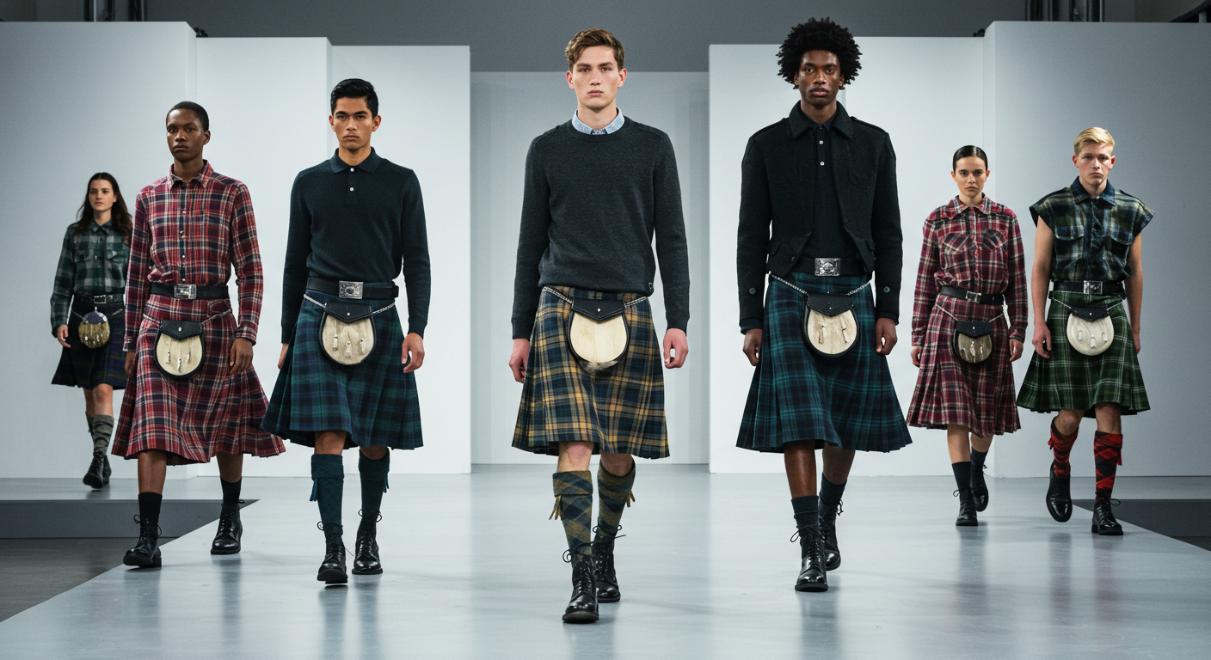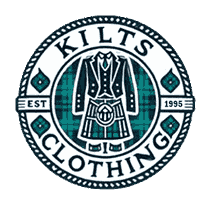The Influence of Scottish Highland Dress on Global Formal Wear Trends

The Scottish Highland dress is not just a symbol of Scotland's rich cultural heritage; it has become a global icon in fashion. The traditional garments, most notably the formal kilt, have had a profound influence on formal wear trends around the world. From military uniforms to weddings and modern-day fashion collections, the legacy of Scottish Highland dress continues to shape how we think about formal attire. This article explores the enduring impact of Scottish Highland dress on global fashion and its transformation from a symbol of national pride to a stylish, worldwide trend.
1. The Origins of Highland Dress: A Cultural and Historical Symbol
The roots of Scottish Highland dress can be traced back to the 16th century. Initially, the kilt was a practical garment worn by Highland Scots, designed for utility and comfort in the rugged terrain of the Scottish Highlands. This early version, known as the great kilt, was a large piece of woolen cloth draped and tied around the body. The tartan pattern, which would later become iconic, had deep ties to clan identity, with different patterns representing various Scottish clans.
By the 18th and 19th centuries, the kilt evolved from a utilitarian piece of clothing into a more formal attire, particularly during ceremonial events. It became a symbol of Scottish nationalism, with the adoption of the kilt by the British military and later by Scottish regiments in the British Army. The uniformity of Highland dress, combined with its strong ties to Scottish identity, helped it move from a regional tradition to a formal and even fashionable attire embraced worldwide.
2. The Kilt: From Scottish Tradition to Global Icon
At the heart of Highland dress lies the kilt, which has evolved from a functional garment to a widely recognized symbol of Scotland. The kilt's global spread began in the 19th century, with Scottish expatriates and cultural ambassadors promoting its distinct look. During the Victorian era, the kilt gained further popularity as it became associated with military regalia and formal ceremonies, especially in Scotland's famed regiments.
In the 20th and 21st centuries, the kilt's transition from military to civilian use helped solidify its place globally. The kilt became popular for formal events like weddings, cultural festivals, and high-profile galas. It was no longer just for Scots; people of all nationalities adopted it for special occasions, drawn to its historical significance, craftsmanship, and distinctive aesthetic. Today, the kilt formal wear is considered a global fashion statement, admired for its blend of tradition and contemporary style.
3. Tartan Patterns: The Global Influence of Scottish Plaid
One of the most recognizable elements of Highland dress is the tartan pattern, often associated with the kilt. Originally a signifier of clan identity, tartan has transcended its Scottish roots to become a staple globally. The intricate, checkered design of tartan has been embraced by major fashion houses, with designers from around the world incorporating the pattern into their collections. From the runways of Paris to the streets of New York, tartan has found its place casually and formally.
The 20th century saw tartan become a symbol of rebellion and individuality. Designers like Vivienne Westwood popularized the pattern during the punk era, using it in ways that broke away from traditional Scottish associations. Today, tartan is used in various ways in both menswear and womenswear, from structured blazers to evening gowns. Its versatility makes it a beloved pattern in formal wear, which continues to evoke a sense of heritage while maintaining its relevance in modern fashion.
4. Scottish Highland Dress in Modern Formal Wear: Weddings, Ceremonies, and Military Uniforms
Highland dress continues to be a prominent choice in various formal settings worldwide. In Scotland, it is a traditional wedding choice, where the groom and groomsmen often don the kilt as part of their attire. The presence of the kilt at weddings in other countries, including the United States, Canada, and Australia, is also growing. Couples choose the kilt for its connection to Scottish heritage, striking appearance, and the statement of individuality it provides. The kilt's ability to marry tradition with elegance makes it an ideal garment for such important occasions.
Highland dress also remains a fixture in military uniforms, particularly within Scottish regiments in the British Army. The distinctive look of the kilt in regimental dress is a powerful symbol of history, pride, and discipline. This use of Highland dress in military settings helped cement its association with full formal kilt and ceremonial attire, giving it global recognition as a respected element of formalwear.
5. Scottish Highland Dress and the Rise of "Dapper" Fashion
The influence of Scottish Highland dress is not limited to traditional events. Over time, elements of Highland fashion, particularly the kilt, have infiltrated mainstream formalwear, contributing to the rise of "dapper" fashion. The structure and formality of Highland attire have influenced the tailored suits, waistcoats, and jackets that characterize dapper dressing.
Designers and brands that focus on sharp tailoring, such as Ralph Lauren and Tom Ford, often incorporate elements inspired by Highland dress, from tartan-patterned accessories to kilt-inspired skirts and trousers. Focusing on precision and craftsmanship, the Highland aesthetic fits seamlessly into the modern dapper look, where style, sophistication, and attention to detail are paramount.
6. Highland Dress in Popular Culture: The Role of Film and Media
The popularity of Scottish Highland dress owes much to its portrayal in film, television, and other media. Films such as Braveheart and Outlander have showcased the kilt and Highland attire, introducing it to a broader, global audience. The romanticized and dramatic depictions of Scottish warriors and historical figures in these productions have led to a resurgence in interest in Highland dress, particularly in non-Scottish countries.
Additionally, celebrities like Sean Connery and, later, stars like Gerard Butler in 300 have worn kilts in films, elevating the garment's cultural cachet and making it fashionable. As the media continues to portray Highland dress as a symbol of strength, history, and rugged individualism, the kilt's appeal grows within and outside Scotland.
7. The Influence of Highland Dress on Contemporary Fashion Designers
Highland dress has left an indelible mark on contemporary fashion, with many designers citing Scottish heritage as an inspiration for their collections. Vivienne Westwood's work with tartan and plaid is one of the most notable examples, with the designer pushing the boundaries of traditional Scottish dress. Other high-profile designers, such as Alexander McQueen, have incorporated elements of Highland attire, from the classic kilt to tartan fabric, into their luxury collections.
These designers often fuse traditional Scottish elements with modern cuts and silhouettes, bridging the gap between old-world heritage and contemporary fashion. This melding of past and present has helped maintain the relevance of Scottish Highland dress in the global fashion scene, ensuring it remains a source of inspiration for future generations of designers.
8. Sustainability and Ethical Fashion: Highland Dress in the Context of Modern Eco-Friendly Trends
In an era where sustainability is becoming a key consideration in fashion, the traditional craftsmanship behind Highland dress aligns with modern eco-conscious trends. Kilts made from natural fibers like wool are renewable and biodegradable, offering an environmentally friendly alternative to synthetic fabrics commonly used in fast fashion. The focus on high-quality materials and ethical production methods means that a well-made kilt can last for years, reducing the need for constant replacements and contributing to a more sustainable fashion cycle.
Many contemporary kilt-makers and designers are incorporating sustainable practices in producing Highland dresses. From sourcing wool from local farms to creating small-batch, handcrafted garments, the resurgence of interest in traditional Scottish attire is in harmony with the growing demand for sustainable and ethically produced fashion.
9. Highland Dress as a Statement of Individuality and Cultural Pride
In today's globalized world, Highland dress has become more than just formal wear; it is a powerful expression of personal identity and cultural pride. People who wear kilts and tartan patterns often do so to celebrate their Scottish heritage or to make a statement about their connection to a particular tradition. The kilt, in particular, is a garment that allows for personalization—whether through custom tartan patterns or unique styling choices. Highland dress empowers individuals to embrace their roots and stand out in a crowd.
Even for those with no direct connection to Scotland, the appeal of the kilt lies in its bold, unique design and its ability to make a statement in formal settings. This sense of individuality is a key reason why Scottish Highland dress continues to resonate with people worldwide.
10. Conclusion: The Enduring Appeal of Highland Dress in Global Fashion
The influence of Scottish Highland dress on global formal wear trends is undeniable. From the kilt's role in military regalia to its place in modern weddings and runways, the legacy of Highland attire continues to shape the fashion world. The combination of tradition, craftsmanship, and versatility ensures that Highland dress remains a fixture in global fashion, admired for its timeless appeal.
As the fashion industry increasingly values sustainability and authenticity, the enduring popularity of Scottish Highland dress speaks to a broader cultural shift toward conscious consumption and the appreciation of heritage. Whether worn as part of a ceremonial outfit or as an expression of individuality, the kilt and tartan patterns have left an indelible mark on the world of formal fashion—and they are likely to continue influencing trends for years to come.


